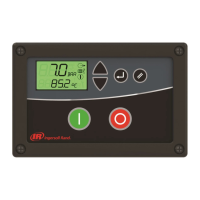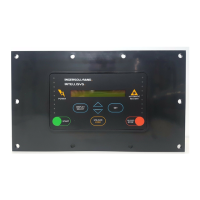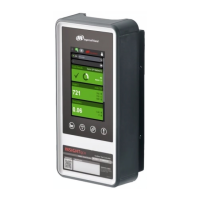SGNe Troubleshooting Guide Page 22
Revision 1.0; Davidson, May 2009. ©Ingersoll Rand Proprietary Information
SGNe
Troubleshooting Guide
Danger
Please utilize extreme caution when performing work within the compressor cabinet.
When opening the cabinet: be certain to wear appropriate PPE (Personal Protective Equipment),
follow lock out-tag out procedures, and ensure all safety procedures are followed
.
Isolation Contact (KM1)
The isolation contact will close at power up once VSD status is verified. The isolation
contact will only open on loss of power, emergency stop, HAT switch, or drive failure.
Drive failure is determined by reading status information from the drive. The isolation
contact will re-close once the drive status is verified and a minimum time period has
expired. The minimum time period is determined by the following. According to
Engineering, the drive can be powered up 5 times consecutively. After that, the
equation (60 – (#
of minutes for 5 power ups)) / 15 will be used.
Start Sequence
The compressor will initially start by pressing the local start button or receiving a remote
start command. The Intellisys will energize the start output to start the VSD. The com-
pressor, most cases will start loaded. The VSD will ramp up the motor speed to its mini-
mum speed. Once the minimum speed has been achieved, the VSD will start to control
pressure by using its speed regulation. When the system pressure approaches the tar-
get pressure, the VSD will start to slow the motor. If the system pressure
rises to the
immediate stop pressure set point the Intellisys will de-energize the start output. If the
system pressure rises to the auto stop set point, the motor is at minimum
speed, and
the blowdown mode is set to Off, the Intellisys will de-energize the start output. However
if the blowdown mode is set to On, the Intellisys will de-energize the blowdown valve and
allow the compressor to run, unloaded, for up to 10 seconds or until the
sump pressure
falls to 35 psi before de-energizing the start output. The Intellisys will re-start the
compressor by energizing the start output once the system pressure falls below the
target pressure. This process will continue until the Intellisys receives a stop command
or has an alarm.
Stop Sequence
The compressor can be stopped by a local or remote stop, a shutdown due to an alarm,
an emergency stop, or a VSD failure. Any of these conditions will cause the start output
to de-energize and the compressor will not automatically restart. All of the above condi-
tions will cause the compressor to stop immediately except the local or remote stop. If
the blowdown mode is set to Off, the compressor will stop immediately. However if the
blowdown mode is set to On, the compressor will first de-energize the blowdown valve
and then run for a maximum of 10 seconds or until the sump pressure falls to 35 Psi
before de-energizing the start output. This compressor will stop if the system pressure
reaches the automatic stop or immediate stop pressure set points. The
compressor will
also stop if the sump pressure reaches 170 psi. However, if the compressor stops for
these reasons, it will automatically restart when the system pressure falls below the
target pressure.
The 250 and 300 HP, Viper-N, compressors have the following additiona
l stopping logic.
When the start output is de-energized, the VSD will use a 20 second deceleration to
completely stop the motor. By slowly stopping the motor, the oil mist fro
m the airend is
minimized. This is necessary because these models do not have an inlet valve.

